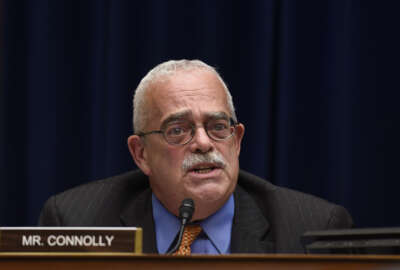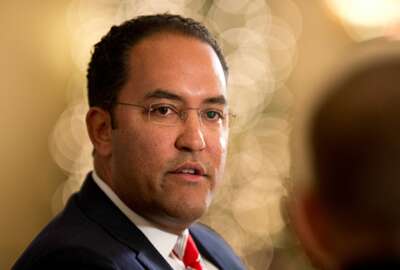
3 takeaways from the FITARA 3.0 hearing
Beyond the federal scorecard, DHS and State provide details on how IT reforms are impacting their respective agencies.
It’s easy to focus on agency grades and lawmakers’ praise and/or outrage during the twice-a-year hearing as part of overseeing the Federal IT Acquisition Reform Act (FITARA). The House Oversight and Government Reform Committee held its biannual session Dec. 6, where we heard mostly good news with 12 agencies improving their grades and 11 agencies earning the same grade as last time.
But what’s really great about these FITARA hearings is finding out what’s happening in agencies underneath the grades.
The State and Homeland Security departments’ chief information officers offered a better understanding of their progress in reforming IT in their respective agencies.
Here are my three takeaways from the FITARA 3.0 hearing:
DHS congruence
Lawmakers spent a large portion of the hearing rightly concerned about the reporting structure of agency chief information officers. The reason both DHS and State CIOs and CFOs testified before the committee was because neither agency’s most senior IT executive reports directly to the deputy secretary or secretary.
One of the reasons the Clinger-Cohen Act — the predecessor to FITARA — fell short was many agencies never met the spirit or intent of the bill’s requirement to elevate the CIO position so it was a true partner at the decision-making table.
Lawmakers honed in on this issue at the hearing and added a new grading section to the latest FITARA scorecard measuring agency CIO reporting structure. The reason for this focus is clear. As the Government Accountability Office’s David Powner, the director of IT management issues, explained the importance in simple terms: CIOs who report to their secretary or deputy secretary scored better than those who didn’t.
DHS CIO Luke McCormack didn’t disagree with the committee or GAO’s opinion on the importance of reporting structure, but he offered an interesting alternative.
“The number one thing in my opinion that makes us a success is what I call goal congruence and a governance structure. Every CXO in DHS has the authority to sort of ‘throw the flag’ in and say ‘I have a problem with that project.’ When I say CXOs, I’m taking about chief procurement officer, the chief human capital officer and certainly myself. All of us are sort of together as a board of directors have that authority,” he said. “In regards to agile development, and this is where goal congruence comes into play, it works. It’s a private sector best practice. If your go out and look at any advanced private sector company that uses IT as a strategic weapon, as I’ll call it, they are all developing it in this kind of process. But you cannot do that if you don’t have the right skills, which means you need your CHCOs to help you hire those folks. You cannot do that unless you have the right procurements in place.”
McCormack said if all of those efforts across the CXOs aren’t aligned, then nothing works, even if the CIO reports to the secretary or deputy secretary.
He said to make progress against any policy or law, the CXOs have to be in the same page from the beginning and stay together throughout the entire lifecycle of a program or project.
To ensure this goal congruence happens, DHS follows several steps, including putting the requirement to participate in the governance board in the CXOs’ performance plans.
McCormack said every project gate review must be approved by all CXOs before it can move forward.
“While you can have the CIO report to the deputy secretary, which is important and could be powerful, but if they are not associated to the individual that you are reporting to, you are still in a negotiation. You are constantly negotiating,” he said. “If that individual is on board and says, ‘We are going to move,’ then you will move.”
McCormack said this process works. He said the board has paused more than one IT project that was struggling for a variety of reasons.
The federal community also has seen evidence of this concept of goal congruence working. McCormack and fellow CXOs — Soraya Correa, the chief procurement officer, Angie Bailey, the CHCO, and Chip Fulghum, the CFO and deputy undersecretary for management — routinely are out on the federal speaking circuit together presenting examples of how working off of the same sheet of paper is paying off.
This is not to say DHS has solved the CIO authorities issue. But it seems to make sense for lawmakers to hold other CXOs accountable for working with their respective CIOs to implement FITARA too.
State is digging out
If Frontis Wiggins, State’s CIO, can meet his stretch goal of raising the agency’s score to a “B” from a “D-” over the next six months, then he will truly be a turnaround specialist.
As Wiggins described the state of IT disrepair the agency was in when he arrived as its CIO five months ago, it was shocking.
“When you look at incremental development, for example, we did not have a mandatory use of incremental development as part of our project management plan. Since I came into this office five months ago, I’ve made that mandatory,” he said. “We did not have an office that focused on workforce. We did not have an IT strategic plan. We did not have a cybersecurity strategy. We did not have a cybersecurity tracker. All of those things have been put in place since I’ve assumed the role. We have a lot of work to do to catch up.”
Listening to Wiggins go through the litany of missing basic IT governance documents, it was no surprise State actually dropped to a “D-” from a “D.” It was a bit surprising that Rep. Robin Kelley (D-Ill.), the ranking member of the IT subcommittee, didn’t follow up on her question about challenges State faces with FITARA by asking why the department, which at one time was a leader especially around cybersecurity, was in such bad shape.
The good news here is Wiggins seems to have a plan and is beginning to make progress. He said State is updating these documents and implementing new tools to address some of its shortcomings.
First off, Wiggins said he’s designating five employees to work only on FITARA implementation.
“To support the full implementation of FITARA at the department, we are in the process of bringing on five employees who will focus on integrating each component of our IT Strategic Plan with our capital planning, budget and planning, and acquisitions initiatives and objectives — as part of the Department’s Electronic Government governance framework. These new staff members will join the Enterprise Program Management Office that supports my office, members of the Department’s governance boards (including the Bureau of Budget and Planning and the Office of Acquisitions Management), and other associated offices and groups,” Wiggins said in an email to Federal News Radio after the hearing. “The five new staff members will work to ensure the department is focused on implementing FITARA by ensuring its legislation is a priority in both high-level discussions, and in daily operations. This scope of support includes working to eliminate duplicative IT projects and initiatives, and ensure that we are selecting and delivering best-in-class IT solutions to support the department’s needs.”
Additionally, Wiggins said the relationship with the department’s CXO community he’s developed over his career will help transform how State uses IT.
One path toward that transformation is a new Budget System Modernization (BSM) project, which will integrate State’s internal budget allocation and execution functions into a more modern, cohesive system by supporting financial planning for IT projects.
“BSM will replace outdated legacy budget systems with greatly improved capabilities. Among these improvements will be greater transparency at a more granular level into planned and budgeted spending, including for IT. It will also consolidate information across systems so that staff can use a single budget system to report on various types of spending,” said Doug Pitkin, State’s director of the Bureau of Budget and Planning, in an email to Federal News Radio after the hearing.
Pitkin said State expects to implement phase one of the tool for financial planning in fiscal 2017.
The fact that Pitkin and Wiggins are working closely on the IT budget aspect of FITARA is a sign of necessary change at State, where the CIO only really controls about 50 percent of all IT spending.
Did CBO really kill the MGT Act?
Reps. Will Hurd (R-Texas) and Gerry Connolly (D-Va.) made clear their unhappiness with the Congressional Budget Office’s scoring of the Modernizing Government Technology (MGT) Act at the FITARA hearing.
The CBO said the bill would cost $9 billion to implement — $3 billion for the Obama administration’s IT Modernization Fund and $6 billion in agency funding that otherwise would’ve been returned to the Treasury.
Hurd said the CBO double counted; its estimates were “ridiculous;” and CBO made some assumptions on $6 billion that were incorrect.
Connolly said, “The priesthood of the CBO … is one that mystifies all of us. The infallibility we invest the CBO with would make the Pope in Rome envious.”
Hurd said the CBO score basically killed the bill for the 114th Congress.
“We ran out of time,” Hurd said in an interview with Federal News Radio after the hearing. “We will pick this back up back in 2017 to get this done. It’s another tool that we can give our CIOs to have the flexibility to introduce new and cutting edge technology into their systems.
But really did the CBO score kill the MGT bill?
It seems unlikely that the Senate would’ve had time to conduct a hearing or a markup of the House’s version. The Senate Homeland Security and Governmental Affairs Committee already had concerns about the current version of the bill, particularly around creating new working capital funds in each agency. This means the upper chamber wouldn’t have attached it to the Defense Authorization bill — a common vehicle for major IT and acquisition reforms — or voted on the House’s language.
Still, Hurd said he believes the Senate is ready to pass the bill.
“But when you get an outrageous CBO score based on incorrect information, that causes everyone to pause. The way the Senate works and only three days left in the business year, we [were unable] to get it in under that timeline,” Hurd said.
Additionally, some say the CBO’s $9 billion price tag is the Oversight and Government Reform Committee’s own fault in the way it wrote the bill.
In CBO’s estimate, the authors highlighted Section 3 of the bill where it would give agencies the ability to reprogram funds from existing accounts. This is where the extra $6 billion comes from. CBO says if agencies were able to extend the life of the funding in existing accounts instead of it reverting back to Treasury, that act would increase the direct spending instead of the money being counted as savings.
“Extending the period of availability for funds that are already appropriated would be a reappropriation and considered to be direct spending. Because agencies would probably want to keep some of those balances for unexpected expenses, CBO estimates that half of that amount would be transferred and used by federal agencies for IT investments over the next two years, increasing direct spending by $3 billion over the next three years,” CBO wrote.
Some say the committee could’ve written the bill in a way that would have let agencies save only money from future accounts instead of current accounts. Add to that the committee’s decision not to say in the bill that the initial $3 billion for the IT Modernization Fund is a one-time hit. Because they leave it open ended, some say it could open the door for future appropriations to the fund.
So while the CBO’s estimate is not helpful for the MGT Act, and could make it more difficult in the 115th Congress, it doesn’t seem likely that a neutral or even positive estimate would’ve made a difference in the final weeks of 2016. Hurd and Connolly are hopeful that an early re-introduction of the bill in 2017 helps pave the way for a quick passage. But with federal CIO Tony Scott expected not to stick around past Jan. 20, getting critical White House support may be difficult and could hamper the bill’s acceptance in Congress.
Return to the Reporter’s Notebook
Copyright © 2025 Federal News Network. All rights reserved. This website is not intended for users located within the European Economic Area.
Jason Miller is executive editor of Federal News Network and directs news coverage on the people, policy and programs of the federal government.
Follow @jmillerWFED
Related Stories






